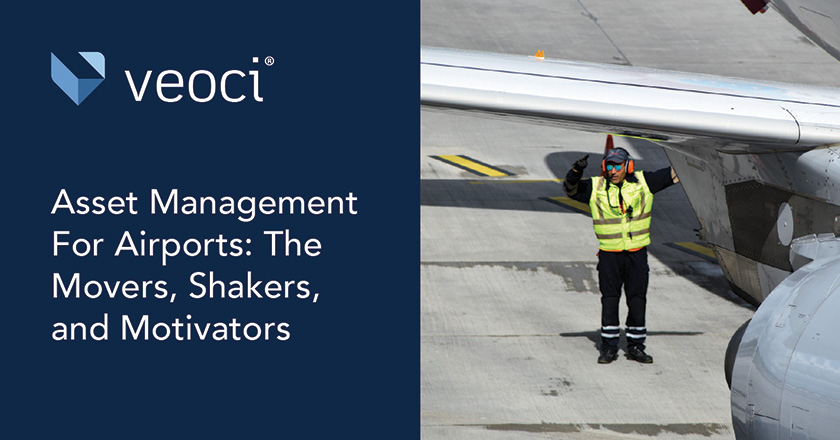A few weeks ago, we published a blog that dove into what asset management is for airports and the importance of having a solution. We promised a follow-up piece dedicated to exploring the different motivations decision makers might have, as well as the differences that must be acknowledged of airports ranging in size.
What are the motivations?
Asset management within an airport can take many shapes. For each decision maker, there are different motivations that influence taking the time to find and then implement software that helps address their challenges within this operation.
The variety of departments and assets means different disciplines and skill sets involved in setting up and implementing a strategy and solution. Though there are multiple departments within airports with unique motivations, here are two we can dive into a bit.
Airfield Vs Operations and Maintenance
People who hear the term airport asset management tend to think of the assets within the airfield. This might be because this is where asset management seems most obviously needed, as this department has (probably) the most regulations to abide by. This is what tends to drive the decision makers in this airport department: compliance, compliance, compliance.
If there is no compliance, there is no take off. Wayfinding signage, pavement, barriers, lights, vehicles — these tools aren’t just there for the workers’ amusement. Each piece is placed carefully and maintained frequently to make sure that everything is up to the regulatory standards demanded for airports. Personnel in the airfield must have a solution that allows them to easily make sure that they are doing everything possible to adhere to those standards, as well as make any necessary changes.
Operations and maintenance departments are often on the hunt to improve one key thing: resource tracking and maintenance.
The only way these departments can complete their responsibilities is by making sure what they need is where they need it at all times. Having an airport resource management tool that helps maintain and keep track of all of the assets is a necessity.
Asset management is the perfect solution to keep tabs on the tools and machines necessary to make sure that airport operations continue. If the resources needed are nowhere to be found, jobs cannot be performed, and the exact performance, that is airport operations, is halted. The solution also helps prolong the lifetime of assets, helping with scheduling regular maintenance and ensuring that tune ups aren’t missed.
Every Airport Needs Asset Management
Really and truly, they do.
The fact stands that whether you are working at a commercial service, cargo or local airport, your airport needs an asset management solution. Now what differs between these airports is their size, and therefore needs when it comes to airport maintenance software?
Clear and effective communication is necessary, regardless of the size of an airport. In a smaller airport you will often find that the workers wear many hats. This means that the appropriate individuals must be included in the processes that they are a part of. They should have a clear way to get the necessary information with the knowledge that they won’t miss an update or misplaced information.
Typically, the bigger the airport is, the bigger their needs are going to be. They could have a higher number of flights, more lessee’s to work with, and more departments to communicate with, so therefore a larger common operating picture to create.
In a larger airport, unlike a smaller airport, tickets like work orders and other processes are often started by one team member and then are sent to another team entirely. There needs to be a solution in place that ensures that requests are not only acknowledged, but followed up on and completed. Conversely, in a smaller airport, inspections and maintenance are typically fulfilled by those who originally put in the request.
Total situational awareness of assets is critical to the success of airport operations. Regardless of size, a solution that is scalable and realistic to your airport’s needs is critical.
Why Veoci?
With so many aspects of, and opportunities for, asset management solutions, it can be hard to identify how and where to start. A platform built by experienced industry practitioners creates a space for deciding and prioritizing assets and functions for your individual airport.
Tracking and housing your assets digitally within a platform like Veoci allows for an easy data trail and an inherent asset history. This also allows you to utilize your assets in other solutions within the software, diminishing the possibility of duplicating information and also allowing each solution’s data to be attached to each individual asset.
Maps of your assets, photos for work orders related to assets, warranty and lifecycle information, all of this can be kept in one space and be made available to anyone who is a part of the related processes.
Deciding on the right solution and platform for your airport, however, should go beyond the capabilities of a software. You deserve to work with a company that has practitioners that can work with you, truly understand the obstacles that you are facing and provide resolutions that are attainable and functional.
Veoci’s Aviation team understands that asset management can feel so wholly overwhelming when an airport is just starting out, or making the decision to move to a different platform. Let our experienced industry professionals help decipher the standards demanded to be met, as well as the best solutions for your specific airport’s needs and goals.








